Understanding the Open Invoice: A Beginner's Guide and NetSuite Tutorial
Every successful business must track, organize, and close invoices efficiently to keep cash flowing. Quality financial software helps manage the entire invoicing process with little stress.
Financial transactions are a business’s most basic building blocks. They’re like the cells that make up a company organism, so if they’re not handled correctly, the entire organism could die.
We don’t want that to happen to your business, so we’ve compiled a simple guide to one of the most essential parts of a financial transaction: the open invoice. The guide digs into the term’s meaning, discusses various types of open invoices, and explains how to manage them. It also features a tutorial on how to search for an open invoice in a NetSuite Enterprise Resource Planning (ERP) system.
SuiteDynamics partners with NetSuite to customize and implement NetSuite ERPs for businesses like yours. Our financial experts can design custom accounting systems that manage all your company’s financial needs—from open invoices to unique processes.
Schedule a consultation with our team today and experience the satisfaction of operating a business with a well-run, accurate financial system.

What Is an Open Invoice?
An open invoice is a request for payment issued by a seller that has yet to be paid by a buyer. Think of it as an unfinished business transaction in the ledger books. It's an acknowledgment of debt for goods or services still awaiting payment.
“Open invoices are a very common part of the accounting cycle for any growing business that processes credit-based transactions,” financial writer Barbara Cook explains in an article for Tipalti. “Having an ‘open’ or ‘outstanding’ invoice can sound concerning because it’s money you have earned that you have not received. But the reality is that it’s proof of your transaction and can provide flexibility for both parties, which can make for smoother business transactions.”
The invoicing process begins when a company sells a product or service. At that time, the seller sends an invoice to the buyer detailing:
- Amount owed
- Description of the goods or services
- Payment terms
- Due date
This invoice remains "open" until the buyer completes the payment.
According to Versapay’s Annual State of Digitation in B2B Finance report, surveyed AR teams process nearly 2,500 invoices per month on average, excluding outliers. Additionally, 77% say they are behind on invoice processing.
Software, like a NetSuite ERP system, automates invoice processing so businesses can handle these large volumes more efficiently. It reduces manual entry, speeds up processing time, and decreases the risk of error.
SuiteDynamics experts can explain NetSuite invoice processing further during your free consultation. We’ll show you how easily the system can free your finance personnel to focus more on growing your business.
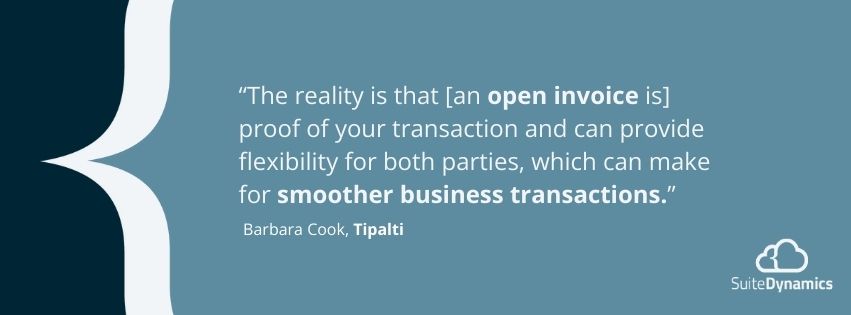
Handling Issues With Open Invoices
An open invoice is like a log in a river. Too many will halt your cash flow. That’s why we suggest incorporating these tips into your operations to help close pending invoices as quickly as possible:
- Communicate Promptly: Address discrepancies or delays in payment by keeping an open line of communication with the other party.
- Maintain Clear Records: Keep detailed records of all transactions and communications to resolve disputes more effectively.
- Create Flexible Solutions: Be open to negotiating payment plans or resolving disputes to maintain good business relations.
- Use Technology: Implement automated accounting software to track invoices, send reminders, and manage payments efficiently.
Automation is a particularly formidable tool for creating efficient and effective invoice processes. In fact, a B2B payments study says automated accounts receivable processes can cut day sales outstanding by 23 days on average for companies handling more than 20,000 invoices per month.
Software such as NetSuite’s invoice processing automatically generates and sends invoices and manages collections while offering payment options such as cash, check, credit card processing, and EFT. This tool reduces the paperwork your accounting team must handle and increases financial data accuracy.
It also saves a significant amount of time and money. The CPA Journal reports that automated invoicing can cost 40% to 90% less than manual processes.
NetSuite’s key invoice processing features include:
- AR Aging – NetSuite’s AR Aging report lists overdue invoices and categorizes them by due date. The system allows you to set your own terms for what constitutes “overdue,” and you can offer discounts for early payments.
- Automatic Sending – You can program the system to send invoices as they’re generated. If you’re billing hourly, NetSuite can invoice when your employees enter hours and/or expenses. Additionally, you can use NetSuite to process these documents in batches overnight.
- Automatic Deposits – You can establish rules in NetSuite that govern how it records payments. It can automatically apply customer payments to corresponding invoices and immediately enter the general ledger account or collect in a designated account to be deposited later as a lump sum.
- Automatic Dunning – If invoices stay open, eventually, they will become “outstanding.” NetSuite’s automated dunning letter procedure manages delinquent accounts so you can maintain cash flow.
This list only covers the basics of NetSuite’s financial automation capabilities. Explore the system’s features further during your free consultation with SuiteDynamics.
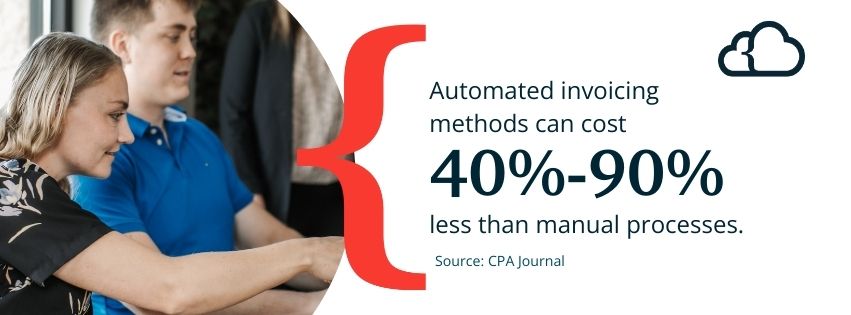
How to View an Open Invoice in NetSuite
NetSuite offers multiple ways to search for an open invoice and filter the results. Below, you can see how easy it is to find the invoice you need using any search method.
Option 1: Global Search Bar
- Find the global search bar at the top of the NetSuite interface.
- In the search bar, type "Open Invoices" to quickly find the open invoice page.
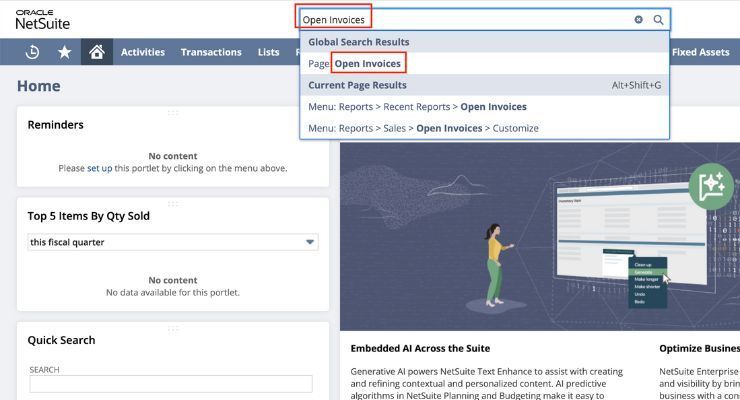
Option 2: Customer Record
- Open a customer record.
- Navigate to the Sales subtab.
- You will see all invoices associated with this customer.
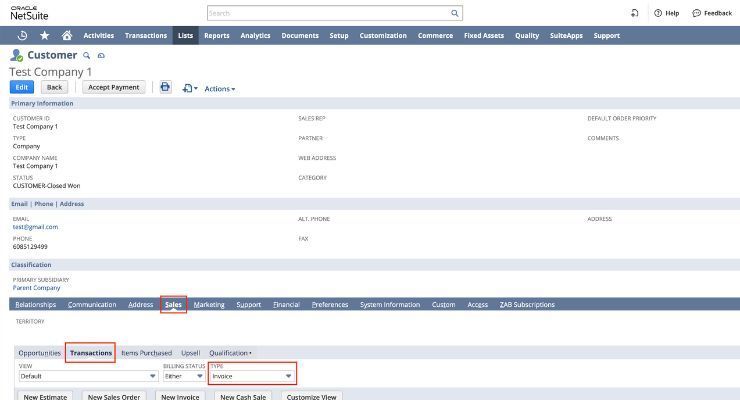
Option 3: Navigation Menu
- Click on the Transactions menu.
- Hover over Sales to open the submenu.
- Navigate to Create Invoices>List.
- Look for filters or a search bar to refine the list to only show open (unpaid) invoices.
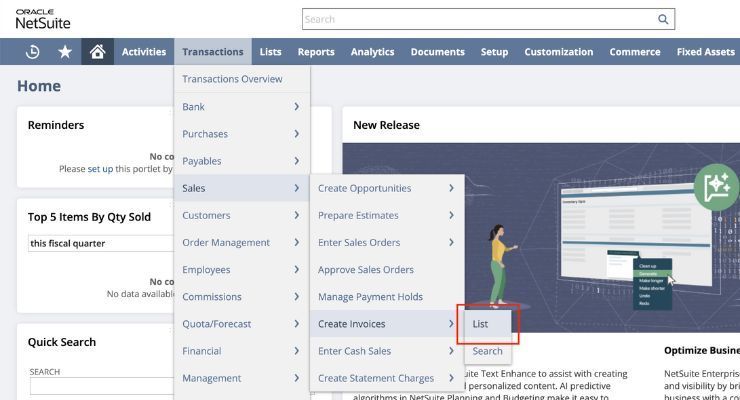
How to Apply Filters
- On the page listing invoices, you may see all invoices by default. Narrow the list to open invoices by finding a filter or a column titled Status.
- Set the filter to “Open” to display only unpaid invoices. NetSuite may have different filters or customization options depending on your setup, so explore the available filters to get the list you need.
(Note: You can also customize the fields listed in this search and the filters you want to search by customizing the view and saving the new view.)

Keep Cash Flowing
Open invoices are common in business, but they need careful tracking. Otherwise, they can compromise cash flow.
Competent financial management paired with world-class accounting software, like a NetSuite ERP system, can help your company resolve an open invoice quickly. This efficiency keeps your cash stream flowing and strengthens your relationships with customers and suppliers because you can meet deadlines and produce consistent goods and services.
We know you can’t afford the compounding problems associated with unresolved invoices and poor financial management. SuiteDynamics can customize and implement a NetSuite ERP with specialized accounting solutions designed by our in-house financial experts.
Schedule a consultation with us today and discover how well your business can run.
We pull information from NetSuite material, SuiteDynamics experts, and other reliable sources to compose our blog posts and educational pieces. We ensure they are as accurate as possible at the time of writing. However, software evolves quickly, and although we work to maintain these posts, some details may fall out of date. Contact SuiteDynamics experts for the latest information on NetSuite ERP systems.
Part of this text was generated using GPT-3, OpenAI’s large-scale language-generation model. After generating the draft language, our team edited, revised, and fact-checked it to ensure readability and accuracy. SuiteDynamics is ultimately responsible for the content of this blog post.











